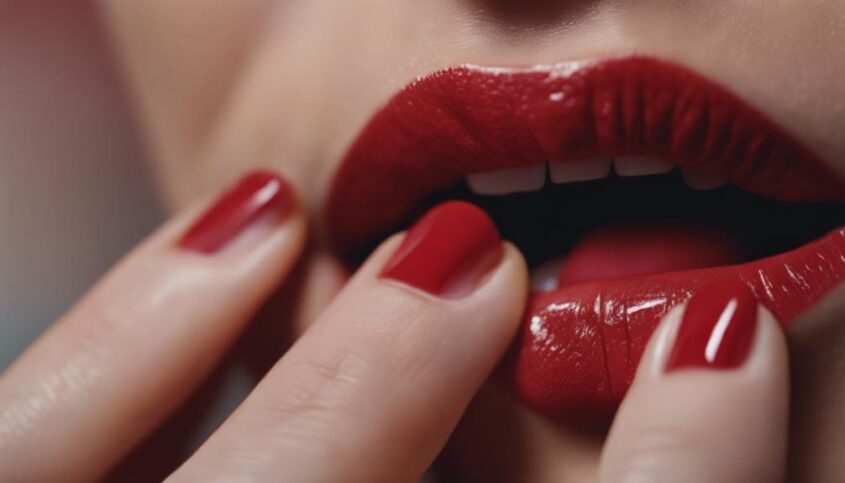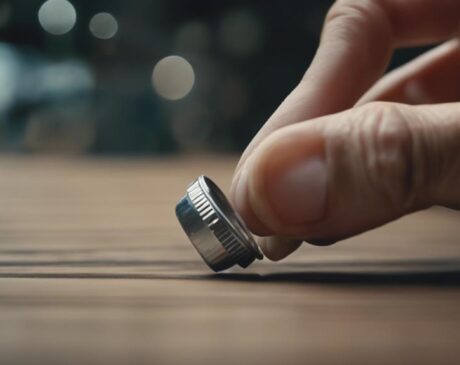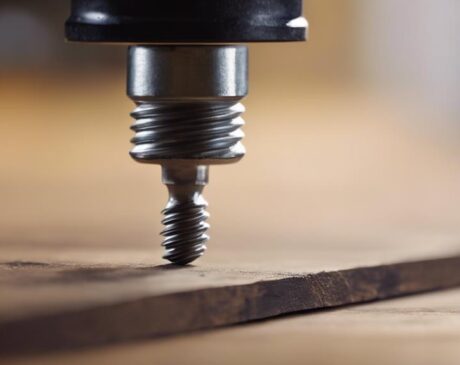Why Do Fake Nails Hurt After Getting Them Done?

Discomfort and pain after fake nail application can be due to factors like nail bed damage, improper application techniques, allergic reactions, excessive nail length, and pressure on the nail beds. Nail bed damage from incorrect application or removal can lead to irritation and infections. Applying too much pressure, using incorrect nail sizes, or improper glue application can also cause soreness and discomfort. Opting for high-quality products and proper nail care can help prevent these issues. Understanding these factors can lead to a more comfortable and enjoyable artificial nail experience.
Key Takeaways
- Nail bed damage from improper application causes discomfort.
- High pressure during application can stress the nail bed.
- Allergic reactions to fake nails can lead to pain.
- Excessive nail length strains the nail bed.
- Incorrect sizing puts pressure on nail beds, causing discomfort.
Nail Bed Damage

Nail bed damage can result from improper application or removal of fake nails, leading to discomfort and pain. When fake nails are not applied correctly, the adhesive can seep into the nail bed, causing irritation and potentially leading to infections. Similarly, aggressive removal techniques such as forcefully prying off the fake nails can damage the delicate nail bed tissue, resulting in soreness and tenderness.
To mitigate nail bed damage, innovative techniques and products have emerged in the realm of artificial nail application. For instance, the introduction of gentler adhesive formulas and removal methods that prioritize nail health have been instrumental in reducing discomfort post-application. Furthermore, the use of protective coatings or base coats can create a barrier between the fake nail and the natural nail, minimizing the risk of direct damage to the nail bed.
Innovations in the fake nail industry continue to evolve, aiming to prioritize not only aesthetics but also the health and well-being of the natural nails underneath. By staying informed about proper application and removal techniques, individuals can enjoy the beauty of fake nails without compromising the health of their nail beds.
Improper Application Technique
Improper application technique can lead to discomfort after getting fake nails. High application pressure, using incorrect nail sizes, and errors in glue application are common culprits. Ensuring precision and care during the application process can help prevent potential pain and discomfort.
Application Pressure Too High
Excessive pressure during the application process of artificial nails can lead to discomfort and pain for the wearer, often resulting from a lack of finesse in the technique utilized. When nail technicians apply too much pressure while attaching fake nails, it can cause undue stress on the natural nail bed, leading to soreness and sensitivity. High application pressure may also result in the artificial nails being secured too tightly, causing them to press against the nail bed uncomfortably. To address this issue, technicians should be trained to apply the right amount of pressure evenly across the nail to ensure a secure bond without causing discomfort. By adopting gentler and more precise application techniques, nail professionals can mitigate the risk of pain and enhance the overall experience for clients seeking artificial nail enhancements.
Incorrect Nail Size
Choosing the appropriate size for artificial nails is paramount in ensuring a comfortable and secure application for the wearer. Incorrectly sized nails can lead to discomfort and pain after application. When nails are too small, they can pinch the natural nail bed, causing soreness and potential damage. Conversely, oversized nails may not adhere properly to the natural nail, leading to lifting and increased pressure on the nail bed. To prevent these issues, it is crucial for nail technicians to carefully measure and select the correct nail sizes for each individual finger. By prioritizing precision in sizing, the wearer can enjoy a pain-free and long-lasting artificial nail experience.
Glue Application Errors
When applying artificial nails, the technique used for glue application plays a crucial role in ensuring a comfortable and long-lasting wear. Glue application errors are a common cause of discomfort and potential damage to the natural nails. Proper application involves using the right amount of glue – too little can result in the artificial nails popping off, while too much can lead to a bulky and uncomfortable fit. Ensuring that the glue is evenly spread on the natural nail and the artificial nail can prevent air pockets that cause pain. Additionally, applying pressure uniformly when securing the artificial nail in place is essential for a secure and comfortable bond. By mastering the art of precise glue application, individuals can enjoy their artificial nails without experiencing unnecessary pain or discomfort.
Allergic Reactions
Allergic reactions to fake nails can manifest as skin irritation and sensitivity to the chemicals present in the products used during the application process. These reactions can cause discomfort and pain, leading to a negative experience for individuals who have a sensitivity to certain substances commonly found in artificial nail products. It is crucial to be aware of potential allergic reactions and take necessary precautions to prevent any adverse effects when getting fake nails done.
Skin Irritation
Skin irritation from fake nails can often result in discomfort and redness due to allergic reactions to the materials used in the application process. Allergic reactions can manifest as itching, swelling, or a rash around the nail bed. These reactions are typically triggered by substances like formaldehyde, toluene, or acrylates found in some nail products. Innovations in nail technology have led to the development of hypoallergenic alternatives for individuals with sensitivities. It is crucial for individuals experiencing skin irritation from fake nails to seek prompt medical attention to prevent further complications. Understanding the ingredients in nail products and opting for allergy-tested options can help mitigate allergic reactions and promote healthier nail care practices.
Sensitivity to Chemicals
Sensitivity to chemicals commonly found in fake nails can lead to adverse reactions in individuals who may be allergic to certain ingredients used in the application process. This allergic reaction can cause discomfort and pain, making the experience of wearing fake nails unpleasant. To provide insight into this phenomenon, consider the following points:
- Chemical Composition: Understanding the specific chemicals present in fake nails can help identify potential allergens.
- Patch Testing: Implementing patch tests before full application can help determine individual sensitivity to the products.
- Alternative Materials: Exploring nail enhancement options that use hypoallergenic materials can mitigate allergic reactions and discomfort.
Excessive Nail Length

Long artificial nails can lead to discomfort and potential damage if they extend beyond a certain length. While many individuals opt for longer artificial nails for aesthetic reasons or to showcase intricate nail art, it is essential to consider the implications of excessive nail length. Nails that are overly long can place strain on the nail bed and surrounding skin, leading to discomfort and even pain. Additionally, excessively long artificial nails are more prone to catching on objects or getting snagged, which can result in the nails getting lifted or torn off, causing further discomfort and potential injury.
To prevent these issues, individuals should consider choosing a length that is manageable and aligns with their daily activities. Opting for a moderate nail length not only reduces the risk of discomfort and damage but also allows for greater functionality and ease of maintenance. By striking a balance between aesthetics and practicality, individuals can enjoy their artificial nails without experiencing unnecessary pain or discomfort due to excessive length.
Pressure on Nail Beds
The application of artificial nails can inadvertently exert pressure on the delicate nail beds, potentially leading to discomfort and complications. This pressure can arise from various factors, including:
- Incorrect Sizing: When artificial nails are not properly sized to fit the natural nail bed, they can put undue pressure on the surrounding tissues, causing pain and discomfort.
- Overlapping Layers: Excessive layers of artificial material can result in a bulky and heavy nail extension, which can press down on the nail bed and lead to soreness.
- Tension from Adhesive: The use of strong adhesives to attach fake nails can sometimes create tension on the nail bed as the glue sets, causing sensitivity and pain.
These pressures on the nail beds can not only cause immediate pain but may also result in long-term damage if not addressed promptly. It is essential to ensure a proper fit and application technique to minimize discomfort and maintain nail health.
Poor Quality Products
Poor quality products used in artificial nail applications can exacerbate discomfort and potential issues for individuals seeking nail enhancements. Substandard materials, such as low-grade acrylics or cheap adhesives, can lead to increased sensitivity and pain after getting fake nails done. These inferior products may not adhere properly to the natural nail, causing lifting, shifting, or uneven application that can create pressure points and discomfort. Moreover, the use of low-quality products can result in brittle, easily breakable nails that are more prone to damage and breakage, further adding to the discomfort experienced by individuals.
Innovative nail technicians and salons are increasingly recognizing the importance of using high-quality products to ensure client satisfaction and comfort. By investing in premium materials that are specifically designed for artificial nail applications, professionals can minimize the risk of discomfort and potential issues for their clients. Clients should also inquire about the products being used during their nail appointments to ensure that they are receiving top-notch service and a comfortable experience.
Infection Risk
To minimize the likelihood of infection, proper sanitation practices must be rigorously followed during artificial nail applications. In the pursuit of flawless nails, it is crucial to prioritize the health and safety of your natural nails and surrounding skin. Here are three innovative ways to reduce the risk of infections during artificial nail procedures:
- Sterilization Technology: Utilize cutting-edge sterilization techniques such as UV sterilizers or autoclaves to ensure that all tools and equipment are free from harmful pathogens before use.
- Antimicrobial Products: Incorporate advanced antimicrobial solutions into your nail care routine to create an environment that is inhospitable to bacteria and fungi, safeguarding against potential infections.
- Disposable Tools: Embrace the use of disposable tools whenever possible to minimize the risk of cross-contamination between clients and ensure a hygienic nail application process. By staying at the forefront of sanitation practices, you can enjoy beautiful artificial nails without the worry of infections compromising your nail health.
Incorrect Nail Removal
Improper removal techniques of fake nails can lead to discomfort and damage to the natural nail bed. When fake nails are not removed correctly, it can result in pain, soreness, and weakening of the natural nails. One common mistake is forcefully peeling or ripping off the fake nails, which can cause trauma to the nail bed and lead to potential infections. The excessive force applied during improper removal can also result in the thinning of the natural nails, making them more susceptible to breakage and sensitivity.
To avoid these issues, innovative nail removal methods have been developed to ensure a safe and pain-free process. Techniques such as soaking the nails in acetone or using special nail wraps can help dissolve the adhesive gently, allowing the fake nails to be removed without causing harm to the natural nails. By embracing these innovative removal methods, individuals can maintain the health and integrity of their natural nails even after using fake nails.
Frequently Asked Questions
Can Fake Nails Cause Long-Term Damage to Natural Nails?
Fake nails can potentially cause long-term damage to natural nails if not applied or removed properly. It's important to follow best practices, seek professional application, and allow for adequate nail care to minimize risks.
Are There Any Long-Term Health Risks Associated With Wearing Fake Nails?
Like a double-edged sword, the allure of fake nails presents potential long-term health risks. While enhancing aesthetics, extended wear may lead to weakened natural nails, fungal infections, and allergic reactions. Regular maintenance and care are crucial.
How Can I Prevent Fake Nails From Lifting or Causing Discomfort?
To prevent fake nails from lifting or causing discomfort, it is crucial to ensure proper application by a skilled technician, opt for high-quality products, maintain good nail hygiene, avoid excessive exposure to water, and follow recommended maintenance routines to prolong wear and minimize potential issues.
Is It Normal for Fake Nails to Feel Sensitive or Sore After Getting Them Done?
It is not uncommon for individuals to experience sensitivity or soreness after getting fake nails done. This discomfort can be due to the pressure exerted during the application process. Proper post-care can help alleviate these sensations.
Can Fake Nails Affect the Growth and Health of the Natural Nail Bed Over Time?
Fake nails can potentially impact the growth and health of the natural nail bed over time due to prolonged wear. Understanding proper application methods and allowing for periodic breaks can help maintain nail bed integrity.




